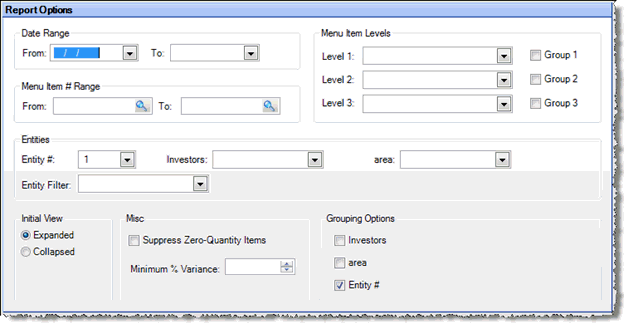
This report allows you to generate a list of the theoretical cost (the cost of all ingredients) of menu items and contribution each makes to your restaurant's profit. Also, if you use target cost percentages, you can determine where opportunities exist to increase profits.
Note: To use this report, you must also use the Compeat POS Polling feature.
The cost is termed 'theoretical' because of variances in serving portions and assumptions about sales quantities and costs made from available data. Compeat takes the recipe of the menu item, calculates a weighted average cost of each ingredient during the specified time period, and then sums these costs to determine a theoretical menu item cost.
If an item was not purchased during the time period being reported on, Compeat will search for the last time the item was purchased, and will display that price on the report; in this case, the price is not an average.
Note: If an item has never been purchased (entered on an invoice or manual check), Compeat will use the Inv. Unit Cost defined on the Restaurant Inventory Items screen. If that field is blank, the cost will show as zero.
The theoretical cost percentage of a menu item is calculated by dividing the theoretical cost by the menu item's average sales price for the period.
The report includes drill-down capabilities that allow you to access related data for an item by clicking on it from the Preview screen. Drill-down capabilities are available for the Menu Item #, Menu Item Description, Qty Sold, and Total Sales fields.
The options screen appears similar to the following:

Use the following options to customize your report:
Date Range Enter a date range for the time period you would like to include in your report. This field is required.
Note: Only menu items sold in the restaurants during the Date Range are included in the report.
Menu Item # Range To limit the report to a particular menu item, or range of menu items, enter the menu item number or range of numbers.
Menu Item Levels To limit the report to a particular menu item level, enter the menu item level. Leave blank for all. Check Group next to a level to group items in the report by that level.
Initial View Select whether to show the report in collapsed form (summary) or expanded form (detail). This can be changed in the report preview screen.
Misc
Suppress Zero-Quantity Items Check this checkbox to omit menu items with a quantity of zero from your report.
Minimum % Variance Specify a percentage variance of theoretical cost % from target cost % below which menu items will not be listed. This allows you to restrict the report to menu items that are significantly away from your target cost percentages.
Grouping Check any grouping you would like to apply to the report.
The Menu Item Theoretical Cost report appears similar to the following:

Each item is identified by its Item # and Description at the beginning of the row. Results are sorted by Opportunity.
Avg Sale Price Shows the average sale price of the item as dollars/item. This is calculated by dividing the total sales in dollars by the total quantity sold (Total Sales /Qty Sold) over the specified time period.
Theo Cost
(Theoretical Cost per item) This is a representation of the menu item
cost. It is theoretical because
it is a calculated value that takes into account sales quantities
from the sales mix and recipe portions.
If an item was not purchased during the time period being reported
on, Compeat will search backwards for the last time the item was purchased,
and will display that price on the report; in this case, the price
is not an average.
Theoretical cost is always calculated using a weighted average, regardless
of the inventory valuation method selected.
Note: If an item has never been purchased (entered on an invoice or manual check), Compeat will use the Cost per Inv. defined on the Restaurant Inventory screen.
Contribution The contribution, or contribution margin, represents gross profit. This is calculated as Avg Sale Price – Theo Cost.
Qty Sold Shows the total quantity of items sold for the date range selected. This includes the sum of all time periods from the sales mix data.
Total Sales Shows the total amount sold in dollars for the date range selected. This includes the sum of all time periods from the sales mix data.
Total Theo Cost Displays the total theoretical cost. This is calculated as Theo Cost x Qty Sold.
Total Contribution This is calculated as Total Sales - Total Theo Cost.
Theo Cost % Shows the theoretical cost as a percent of total sales. This is calculated as (Total Theo Cost/Total Sales) x 100%.
Target Cost % Displays the target cost percent as defined on the Menu Items screen.
Cost Var % Shows the percent variance from the target cost. This is calculated as (Theo Cost % – Target Cost %)/Target Cost %.
Opportunity
Opportunity represent the dollars gained (positive) or lost (negative)
by selling the menu item at a theoretical cost percentage below or
above (respectively) the target cost percentage. This is calculated
as (Total Contribution –
(Total Sales –
(Target Cost Percent/100) x Total Sales))).
This information allows you to see where real cost percent is not meeting
target cost percent. There are two factors that affect this: cost
of ingredients and sale price of the menu item. To correct a negative
opportunity number, you can either lower the cost of ingredients (for
example by shopping better vendor prices), or raise the price of the
item.